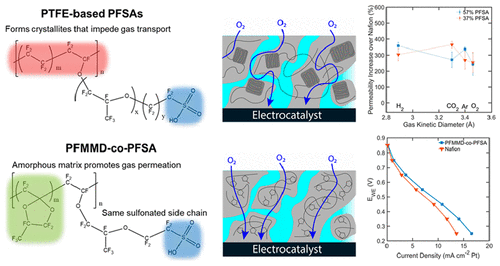当前位置:
X-MOL 学术
›
J. Am. Chem. Soc.
›
论文详情
Our official English website, www.x-mol.net, welcomes your
feedback! (Note: you will need to create a separate account there.)
Highly Permeable Perfluorinated Sulfonic Acid Ionomers for Improved Electrochemical Devices: Insights into Structure – Property Relationships
Journal of the American Chemical Society ( IF 14.4 ) Pub Date : 2020-01-20 , DOI: 10.1021/jacs.9b09170 Adlai Katzenberg 1, 2 , Anamika Chowdhury 2, 3 , Minfeng Fang 1 , Adam Z Weber 2 , Yoshiyuki Okamoto 1 , Ahmet Kusoglu 2 , Miguel A Modestino 1
Journal of the American Chemical Society ( IF 14.4 ) Pub Date : 2020-01-20 , DOI: 10.1021/jacs.9b09170 Adlai Katzenberg 1, 2 , Anamika Chowdhury 2, 3 , Minfeng Fang 1 , Adam Z Weber 2 , Yoshiyuki Okamoto 1 , Ahmet Kusoglu 2 , Miguel A Modestino 1
Affiliation

|
Rapid improvements in polymer-electrolyte fuel-cell (PEFC) performance have been driven by the development of commercially available ion-conducting polymers (ionomers) that are employed as membranes and catalyst binders in membrane-electrode assemblies. Commercially available ionomers are based on a perfluorinated chemistry comprised of a polytetrafluoroethylene (PTFE) matrix that imparts low gas permeability and high mechanical strength but introduces significant mass-transport losses in the electrodes. These transport losses currently limit PEFC performance, especially for low Pt loadings. In this study, we present a novel ionomer incorporating a glassy amorphous matrix based on a perfluoro(2-methylene-4-methyl-1,3-dioxolane) (PFMMD) backbone. The novel backbone chemistry induces structural changes in the ionomer, restricting ionomer domain swelling under hydration while disrupting matrix crystallinity. These structural changes slightly reduce proton conductivity while significantly improving gas permeability. The performance implications of this tradeoff are assessed, which reveal the potential for substantial performance improvement by incorporation of highly permeable ionomers as the functional catalyst binder. These results underscore the significance of tailoring material chemistry to specific device requirements, where ionomer chemistry should be rationally designed to match the local transport requirements of the device architecture.
中文翻译:

用于改进电化学装置的高渗透性全氟磺酸离聚物:结构洞察 - 性能关系
聚合物电解质燃料电池 (PEFC) 性能的快速改进得益于商业上可用的离子导电聚合物(离聚物)的开发,这些聚合物用作膜电极组件中的膜和催化剂粘合剂。市售离聚物基于由聚四氟乙烯 (PTFE) 基质组成的全氟化化学物质,该基质具有低透气性和高机械强度,但会在电极中引入显着的传质损失。这些运输损失目前限制了 PEFC 的性能,特别是对于低 Pt 负载。在这项研究中,我们提出了一种新型离聚物,它包含基于全氟(2-亚甲基-4-甲基-1,3-二氧戊环)(PFMMD)骨架的玻璃状无定形基质。新的骨架化学诱导离聚物的结构变化,限制离聚物域在水合作用下膨胀,同时破坏基质结晶度。这些结构变化略微降低了质子传导性,同时显着提高了气体渗透性。评估了这种权衡的性能影响,这揭示了通过引入高渗透性离聚物作为功能催化剂粘合剂来显着提高性能的潜力。这些结果强调了根据特定设备要求定制材料化学的重要性,其中应合理设计离聚物化学以匹配设备架构的局部传输要求。评估了这种权衡的性能影响,这揭示了通过引入高渗透性离聚物作为功能催化剂粘合剂来显着提高性能的潜力。这些结果强调了根据特定设备要求定制材料化学的重要性,其中应合理设计离聚物化学以匹配设备架构的局部传输要求。评估了这种权衡的性能影响,这揭示了通过引入高渗透性离聚物作为功能催化剂粘合剂来显着提高性能的潜力。这些结果强调了根据特定设备要求定制材料化学的重要性,其中应合理设计离聚物化学以匹配设备架构的局部传输要求。
更新日期:2020-01-20
中文翻译:

用于改进电化学装置的高渗透性全氟磺酸离聚物:结构洞察 - 性能关系
聚合物电解质燃料电池 (PEFC) 性能的快速改进得益于商业上可用的离子导电聚合物(离聚物)的开发,这些聚合物用作膜电极组件中的膜和催化剂粘合剂。市售离聚物基于由聚四氟乙烯 (PTFE) 基质组成的全氟化化学物质,该基质具有低透气性和高机械强度,但会在电极中引入显着的传质损失。这些运输损失目前限制了 PEFC 的性能,特别是对于低 Pt 负载。在这项研究中,我们提出了一种新型离聚物,它包含基于全氟(2-亚甲基-4-甲基-1,3-二氧戊环)(PFMMD)骨架的玻璃状无定形基质。新的骨架化学诱导离聚物的结构变化,限制离聚物域在水合作用下膨胀,同时破坏基质结晶度。这些结构变化略微降低了质子传导性,同时显着提高了气体渗透性。评估了这种权衡的性能影响,这揭示了通过引入高渗透性离聚物作为功能催化剂粘合剂来显着提高性能的潜力。这些结果强调了根据特定设备要求定制材料化学的重要性,其中应合理设计离聚物化学以匹配设备架构的局部传输要求。评估了这种权衡的性能影响,这揭示了通过引入高渗透性离聚物作为功能催化剂粘合剂来显着提高性能的潜力。这些结果强调了根据特定设备要求定制材料化学的重要性,其中应合理设计离聚物化学以匹配设备架构的局部传输要求。评估了这种权衡的性能影响,这揭示了通过引入高渗透性离聚物作为功能催化剂粘合剂来显着提高性能的潜力。这些结果强调了根据特定设备要求定制材料化学的重要性,其中应合理设计离聚物化学以匹配设备架构的局部传输要求。


















































 京公网安备 11010802027423号
京公网安备 11010802027423号